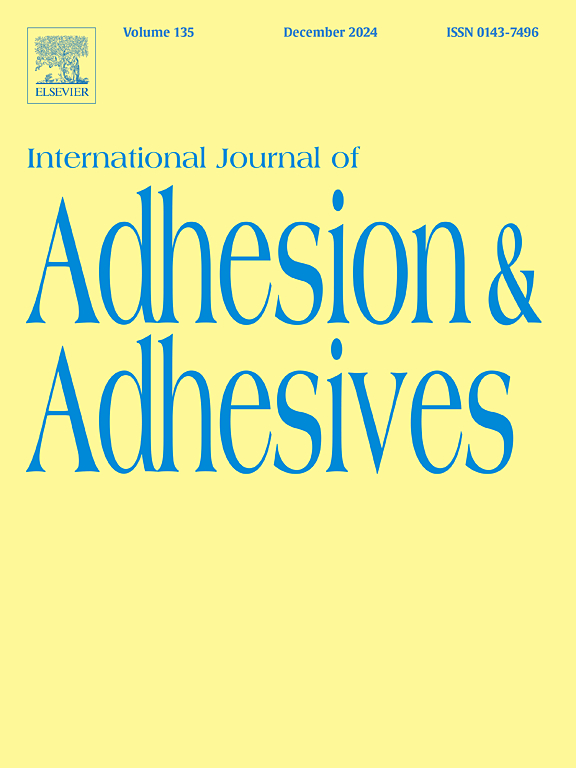使用3d打印聚合物构建的单搭接混合接头的多阶段操作,铝粘合剂进行单轴拉伸测试
IF 3.2
3区 材料科学
Q2 ENGINEERING, CHEMICAL
International Journal of Adhesion and Adhesives
Pub Date : 2025-02-08
DOI:10.1016/j.ijadhadh.2025.103976
引用次数: 0
摘要
本文介绍了单搭接混合接头的室内试验结果。试件采用了一种榫卯式机械接头和厚度为0.6 mm的双面Very High Bonding (VHB) 5925胶带。机械接头负责增加刚度和强度,粘接接头负责显著的能量吸收。其中一个附着物,以及榫头,是由Z-ABS材料3D打印制成的。其他支架由2毫米厚的铝制成,直径为19毫米。试件分为A、B、C三组,榫头设计不同,通过逐渐损伤机械接头实现多阶段操作。在MTS 25 kN试验机上进行静态单轴拉伸试验。试验过程中,采用“Aramis”数字图像相关(DIC)系统进行应变观测。力-位移图分析表明,关节可能存在一到四个阶段的损伤,这在国际文献中是新的。与参考粘接相比,最大损伤力增加了185.4%,吸收能量增加了17.8%。除了促进混合动力关节领域的发展外,研究结果还可用于实际安全关节的设计,例如在汽车或航空航天工业中,在达到最大力后,即使在较大的位移下,关节也可以继续工作并保持完整。本文章由计算机程序翻译,如有差异,请以英文原文为准。
Multi-stage operation of single-lap hybrid joints constructed using a 3D-printed polymer with aluminium adherends subjected to uniaxial tensile test
This paper presents the results of laboratory tests for single-lap hybrid joints. The specimens used a mechanical joint of the mortise-and-tenon type and a double-sided Very High Bonding (VHB) 5925 adhesive tape with a thickness of 0.6 mm. The mechanical joint is responsible for increased stiffness and strength, and the adhesive joint is responsible for significant energy absorption. One of the adherends, along with the tenon, was made by 3D printing from Z-ABS material. The other adherends were made from 2 mm thick aluminium and had a 19 mm diameter hole. The specimens were made in three groups: A, B, and C, differing in tenon design in such a way as to achieve multi-stage operation by gradually damaging the mechanical joint. They were subjected to static uniaxial tensile tests on an MTS 25 kN testing machine. During the tests, strain observations were made using the “Aramis” Digital Image Correlation (DIC) system. Analysis of force-displacement diagrams has shown that one to four stages of joint damage are possible, which is new in the world literature. A maximum increase in damage force of 185.4 % and 17.8 % for absorbed energy was achieved compared to the reference adhesive joint. In addition to contributing to the development of the field of hybrid joints, the results of the research can also be used in practice to design safety joints for example, in the automotive or aerospace industries, where after the maximum force is reached, the joint can continue to work and be integral even under relatively large displacements.
求助全文
通过发布文献求助,成功后即可免费获取论文全文。
去求助
来源期刊

International Journal of Adhesion and Adhesives
工程技术-材料科学:综合
CiteScore
6.90
自引率
8.80%
发文量
200
审稿时长
8.3 months
期刊介绍:
The International Journal of Adhesion and Adhesives draws together the many aspects of the science and technology of adhesive materials, from fundamental research and development work to industrial applications. Subject areas covered include: interfacial interactions, surface chemistry, methods of testing, accumulation of test data on physical and mechanical properties, environmental effects, new adhesive materials, sealants, design of bonded joints, and manufacturing technology.
 求助内容:
求助内容: 应助结果提醒方式:
应助结果提醒方式:


